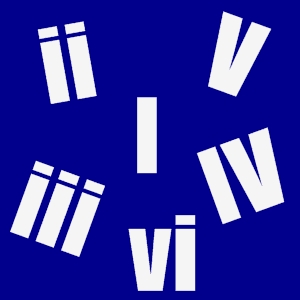 If you want to transpose music like a master musician, there is only one secret, and it has to do with understanding music theory. Not necessarily the entirety of music theory, but at least knowing your keys and chords, and how that relates to the song you are attempting to play.
If you want to transpose music like a master musician, there is only one secret, and it has to do with understanding music theory. Not necessarily the entirety of music theory, but at least knowing your keys and chords, and how that relates to the song you are attempting to play.
Every key is built from a scale, either major or minor. The chords in each key are built on each note of the scale and stacked in thirds (every other note) three notes high. Each note in the scale is assigned a number that is its scale degree, one through seven and then repeating itself endlessly. The way that the thirds distribute in a major key creates the following chords: a major chord on the first scale degree designated by a capital Roman numeral, I, a minor chord on the second and third scale degrees designated by lower case Roman numerals, ii and iii, a major chord on the fourth and fifth scale degrees designated by capital Roman numerals, IV and V, a minor chord on the sixth scale degree designated by a lower case Roman numeral, vi, and finally a diminished triad on the seventh scale degree designated by a lower case Roman numeral with a kind of degree symbol after it, vii°.
What we end up with in a major key such as C Major, are the chords C, Dm, Em, F, G, Am, and B°, which relate to the scale degree labels I, ii, iii, IV, V, vi, vii°. What benefits the master musician is that when you change keys to the next key in the Circle of Fifths, the key of G, even though the chords are G, Am, Bm, C, D, Em, F#°, their scale degree labels are still I, ii, iii, IV, V, vi, vii°, relative to the key of G. Going through the process of knowing the seven chords in each of the Major keys, and yet understanding that they are each tied to a scale degree, makes transposing a breeze. In fact, you’re not even transposing. You’re simply playing the song’s scale degrees in the new key.
So how does this work? It all depends on how you learn the song. If you just learn the song as a string of chords, then you’ll probably have to move each and every chord the distance that you transpose the song, one at a time. If you learn the song as a series of scale degree chord designations, you simply play that array in the new key. For example, if I wanted to play Let It Be by the Beatles, and I learned it in the key they recorded it in, the key of C, I would play C-G-Am-F, C-G-F-C. If it turned out I couldn’t sing as high as Paul McCartney and I needed to drop the song into Bb, I’d have two choices. I could either take each chord down a whole step, one at a time, or I could notice that McCartney’s progression was I-V-vi-IV, I-V-IV-I in the key of C. When I look at the key of Bb, I see the chords are Bb, Cm, Dm, Eb, F, Gm, A°, Bb. I also notice that Bb is the I chord, F is the V chord, Gm is the vi chord, and Eb is the IV chord. Therefore, I just play the appropriate chord at the appropriate time.
While this may seem difficult when you first begin it, as you learn the keys and their chords like the back of your hand, it is really the simplest way to do it, and it’s the way I’ve been doing it for years. Invest some time, know your instrument and some music theory, and you’ll realize it really is the master musician transposing secret.
